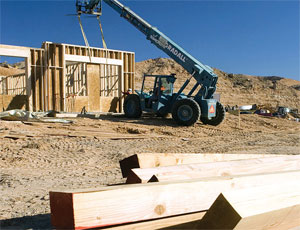Foreclosures, unemployment, tighter lending and unstable prices weigh heavily on the commercial housing sector, but falling demand has not had a similar effect on the cost of materials.

The National Association of Home Builders expects only 550,000 new single-family home starts in 2010, a 63% drop from five years ago but still 25% above 2009. The market downturn has fueled builder bankruptcies, softened real-estate property values and caused an industry leadership rift that led to the formation of a new trade group called the Leading Builders of America (LBA).
The Washington, D.C.-based nonprofit association specifically is geared toward large and publicly traded builders, including Fort Worth-based D.R. Horton; Pulte Homes, Bloomfield Hills, Mich., and Miami-based Lennar Corp. The firms reported a total of $17.5 billion in earnings last year, public records show, placing them within the top five U.S. builders by revenue. LBA members build 25% of new homes sold annually and generate 387,000 direct and indirect jobs a year, the group claims.
Trouble erupted last year over language in the federal economic stimulus measure that extended the time frame to five years, from two, for companies to use tax losses to offset profits. Public builders supported the provision; NAHB questioned it. Large builders would be incentivized to dispose of land and existing home inventory at bargain prices for tax purposes to offset huge profits made during the market boom. But small builders could suffer, claimed NAHB. “The resulting downward pressure on land prices will put smaller builders with debt-financed land in a dangerous position,” said association CEO Gerald Howard in a February 2009 letter to House Speaker Nancy Pelosi (D-Calif.).
Those comments drew the ire of big builders who unsuccessfully tried removing Howard before forming LBA last fall. It is now headed by Ken Gear, former Pulte vice president of government affairs. Members of both groups hope to take advantage of homebuyer tax credits due to expire in April, with 235,000 homes available for sale, or the equivalent of an eight- month supply, NAHB reports. New construction is unlikely to restart until inventory drops to a five-month level and price stability returns, say observers.
Yet less domestic demand is not driving down raw building-material prices. A supply shortage in framing lumber, for example, has propelled a 40% cost increase since last year, says Random Lengths, a Eugene, Ore.-based firm that tracks lumber prices. As of mid-March, it reported prices of $312 per thousand board-ft. Weak demand prompted U.S. and Canadian mills to cut production, reducing output 45% between 2005 and 2009, says Random Lengths.
“Although there is still little sign of inflation for the overall economy, construction is vulnerable to fluctuations in world demand for raw materials, which tend to be much more volatile than consumer prices,” says Ken Simonson, chief economist of the Associated General Contractors of America.
Prices for plumbing fixtures and fittings are up 1.4% from a year ago, and non-ferrous wire and cable costs have increased 22.2% over the same period 12 months ago, according to the U.S. Bureau of Labor Statistics’ Producer Price Index.
Copper recently reached its highest price point since late 2008 due to production interruptions caused by February’s magnitude-8.8 earthquake in Chile, which has the world’s largest reserves. While the quake halted operations at two mining operations owned by Codelco, the government-owned company that produces 11% of the global total, damage was slight in that region and prices are stabilizing. An average 2,100-sq-ft single-family home uses 440 lb. of copper, according to New York City-based Copper Development Association Inc.
Gypsum wallboard costs are also on the rise after steep declines in 2009. Chicago-based USG Corp. and National Gypsum Co., headquartered in Charlotte, N.C., sent letters to distributors in February announcing a 20% wallboard price increase this month, says Nashville-based Thompson Research Group. Its report cites slumping revenue and high production costs as possible reasons for the price hike. USG will temporarily close its wallboard manufacturing plant in Stony Point, N.Y., in June, while L&W Supply Corp., Chicago, will be closing more distribution facilities.


Post a comment to this article
Report Abusive Comment